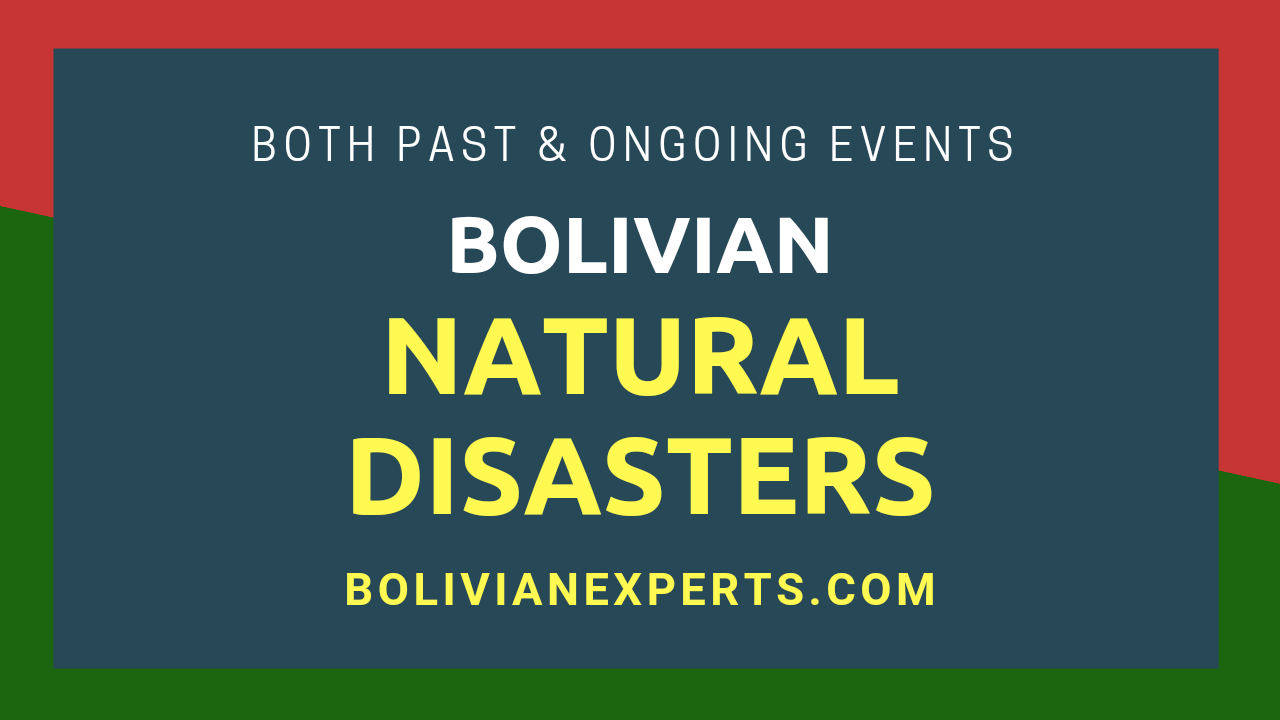Of course that Bolivia experiences natural disasters, but these in general are not as deadly as in other places around the world. Most disasters in the past have involved death tolls of less than 100 people, and the current cyclical natural disasters in the country usually don’t involve any death, although they are still risky and you need to take all the proper cautions to avoid them.
The main natural disasters that occur in Bolivia are 1) major floods in large cities like Santa Cruz, Trinidad, and Cobija, 2) hail storms in La Paz and Sucre; 4) extreme heat or cold in some places 5) droughts and wildfires in Gran Chaco. Other natural disasters usually don’t happen in Bolivia.
Here you’ll know about the most important both past and ongoing natural disasters that exist in Bolivia. You will get all the details, numbers, risks, and precautions, about these events in the country. Also, we’ll show you the 5 main natural disasters in the country.
Bolivia usually doesn’t have too bad natural disasters
It’s really uncommon to see natural disasters that involve more than 100 dead people in Bolivia. In other countries, it’s normal to see events that can kill thousands of people, like tsunamis, cyclones, earthquakes, and similar disasters. But Bolivia is mostly a calm place, where almost nothing very harmful happens.
Warning: Health diseases!
On the other hand, Bolivia has some important endemic health diseases. First is the Chagas Disease, which affects more than 30% of the population in tropical areas. Dengue is also present every year in tropical cities, along with other illnesses like Zika, Yellow Fever, and Malaria.
Be always careful to avoid all these ills, particularly the Chagas Disease, which irreversibly damages the heart, and also Dengue and Malaria, which can be deadly and very difficult to treat.
What natural disasters does Bolivia normally have?
In Bolivia, you’ll find that most natural disasters involve major floods, hail storms, and tropical rain storms. There are also some droughts and wildfires in some regions, additionally, very hot or cold temperatures can happen and in some cases can cause heat waves.
But in the country, it’s very unlikely to see tornadoes, earthquakes, famines, volcanoes, tsunamis, blizzards, cyclones, etcetera.
In the following table, you can see the most important ongoing and cyclical natural disasters (that occur every year) and also several past disasters that left a mark in the memories of the Bolivian population.
| Cyclic Natural disasters | When it happens | Precautions to take |
| Major floods in tropical cities | October to February | Stay in an elevated area of the city |
| Heavy hail storms in the Altiplano | From November to April | Find an elevated place to protect yourself (in Sucre City they’re still deadly) |
| Tropical rain storms in tropical cities | August to February | Find a well-sheltered area to cover yourself |
| Extreme cold or hot in several places | May to August | Use the appropriate clothing, find more out about these events (hot, cold) |
| Major droughts in the Gran Chaco | Suddenly, any time of the year | Don’t get lost there, no urban areas nearby |
| Past natural disasters | Death toll | Date of the event |
| Deadly hail storm in La Paz | 74 people | February 19th, 2002 |
| Deadly hail storm in Sucre | 4 people | January 4th, 2021 |
| Earthquake in Aiquile and Totora | 65 people | May 22th, 1998 |
| Chacaltaya glaciers disappeared | – | September 2009 |
| Popoo Lake has almost dried out | – | August 2021 |
1) Major floods in tropical cities
The largest cities of Bolivia often experience important floods triggered by heavy tropical rain storms and river overflows. Major cities like Santa Cruz De La Sierra, Trinidad, and Cobija, which together account for more than 2 million habitants, experience this issue.
The areas in these cities that get constant floods are:
- Many neighborhoods in Santa Cruz, most of them on the outskirts.
- Rural areas surrounding Trinidad city, sometimes also in the city.
- In the whole of Cobija City, by overflows of the Acre River.
All these cities are located in the tropical region of Bolivia, which is very close in climatic features to the Amazonas, then a lot of rain happens there. These cities are also close to or surrounded by important wide rivers and from time to time they overflow.
The floods that happen in these cities often affect poor people (as wealthy people usually live in areas of the city that are not reached by these floods), leaving them without a home to live in and often requiring shelter. Floods usually occur in the country’s wet season, from September to April.
If you are a tourist visiting these cities, usually you won’t need to worry about these events, hotels, tourist centers, and related places are in general far away from the areas that get flooded. But if you experience a tropical rain storm (which we’re going to talk about later) take all the necessary precautions.
2) Heavy hail storms in the Altiplanic region
In the western cold side of the country, called the Altiplano, it’s common to experience heavy hail storms at the end of the year. These storms can sometimes be deadly, as happened several times ago.
Past deadly hail storms in La Paz City
For example, in La Paz City, every year 1 to 5 intense hail storms are going to happen, mostly between November and February. In the past, one of these storms in the city was so heavy and catastrophic that it killed 74 people, it happened on February 19th, 2002.
This hail storm was so intense that the main streets of the city suddenly became mighty rivers that dragged people and cars into the sewage system of the city. In other streets hail deposits buried many unaware people, even inside their homes.
Since that time, the local government of La Paz has made efforts to improve the sewage system of the city to prepare it for similar storms in the future. And after that tragic event, no other hail storm has been deadly in the city. But these hail storms haven’t diminished in power and are still dangerous.
Hail storms in La Paz are usually quite intense and risky, and they tend to happen every year from November to February. When being in this situation, you must always find a highly elevated place, well sheltered, to protect yourself.
Still deadly storms in Sucre City
Not too long ago, in 2021, a deadly hail storm occurred in Sucre City, the former political capital of Bolivia. In this disastrous event, 4 people died and many more were injured.
This happened because this city, the same as La Paz city, is not a plain terrain, it rather has the form of a canyon where water gets a lot of the force as it goes down the roads. So the streets, because of the huge amount of fallen hail, suddenly become mighty rivers.
And these sudden mighty rivers on the streets start to drag people into the drain system or inside areas where there is no oxygen or air to breathe, also adding to the cold these waters are at that moment. All of these factors are what end up killing people when these hail storms happen.
Hail storms in other places in Bolivia
These heavy and even deadly hail storms can occur in the following several places:
- In La Paz City (deadly in the past)
- In the north of Potosí (rural areas)
- In Sucre City (still deadly)
- In Tarija City
There are other places in Bolivia like the north or Potosí or Tarija City where you can experience very heavy hail storms at the end of the year, but these, in general, are not deadly or too risky. Anyway, you should always take all the necessary precautions.
3) Tropical rain storms in tropical cities
Intense tropical rain storms are very common at the end of the year, from August to February, in large cities, like Santa Cruz, Trinidad, and Cobija. These are tropical, even Amazonian urban areas that get a lot of rainfall throughout the whole year.
These tropical rain storms in the mentioned cities are characterized by:
- Lasting many hours, with huge amounts of constant rain.
- Winds of over 40 miles per hour (>65 km/h) and the overthrow of large trees and even building structures.
- Lightning strikes that can be dangerous for people on the streets and sometimes can reach them (few cases are known).
- This huge drop in rainfall can cause sudden floods across the city.
When these rain storms happen, you often see that large trees wobble and are even uprooted, also some parts and roofs of houses get lifted, fly and become dangerous. The vehicle traffic turns very chaotic, and all the streets around start to become flooded. Despite all of this, it’s unlikely to have deaths from these events when they happen.
Whenever you encounter yourself in an intense rain storm in Santa Cruz, Trinidad, or Cobija cities, and urban areas nearby, avoid being in open places (risk of flying objects and lightning strikes), and move to an upper area of the city in a sheltered place. If you are on the outskirts, be aware that floods on streets may suddenly appear at that moment.
4) Extreme cold or hot in some cities sometimes of the year
Bolivia is a country that has many different climates. Some regions with extreme cold temperatures can trigger hypothermia, also in other regions, with very hot temperatures can trigger heat waves.
Places that get very cold
Cold weather is normal in the following places, but sometimes these very freezing temperatures can drive several disasters.
The places that can get very cold, reaching temperatures of 15°F (-10°C) or less at some times in the year are
- De Los Andes mountain range, for alpinists and climbers.
- The Altiplano region and its cities, like La Paz, El Alto, Oruro, and Potosí
- The Uyuni’s Salt Flat, Red Lagoon, Eduardo Avaroa National Park, and nearby places.
- The southwest part of the Potosí department and the towns inside.
You can get hail storms that can destroy large agricultural lands (as often happens every year in the southwest of Potosí) or can strike main cities as we’ve shown before. Also, freezing temperatures can trigger hypothermia for homeless and drunk people in the mentioned places.
We have a complete guide about the coldest places in Bolivia, in which we talk in detail about the temperatures, coldest seasons, and also precautions to take in these places: The coldest places in Bolivia, a full overview.
Places that get very hot
Almost 40% of the Bolivian territory has a climate very similar to the Amazonas, but a little bit dryer, where very hot temperatures are common and they can trigger some natural disasters.
The places that can get very hot reaching temperatures of 105°F (40°C) or more at some moments of the year are:
- Both rural and urban areas are inside the Gran Chaco region.
- Across the tropical eastern part of Bolivia, including large cities like Santa Cruz, Trinidad, and Cobija.
- Tourist places like The Madidi National Park, Rurrenabaque, The Chiquitania, and places around.
Very hot temperatures in all these places can result in heat waves, droughts, and wildfires, as what happens in the Gran Chaco, as well as rain storms in large cities, as we showed before, also major floods and similar situations. They can also trigger heat strokes for unaware people outside on a sunny day.
We have a detailed guide that will give you all the information about the hottest places that exist in Bolivia, their weather and temperatures, including all the precautions to take, in the following direction: The hottest places in Bolivia, everything to know.
5) Major droughts and wildfires in the Gran Chaco region
The Gran Chaco is a tropical savanna of Bolivia where it can get very hot all year long, but even hotter from September to April. The very high temperatures, adding to the lack of rainfall, can drive sudden droughts in this place. These droughts can appear at any time of the year and can last for a long time.
Also, the lack of water and rainfall along with the really hot temperatures often drive extensive wildfires in this region. Very often both droughts and wildfires in Gran Chaco require the Bolivian government to act and provide help and support in this area.
There are no large cities in the Gran Chaco, this is also not a tourist place often visited by foreigners, but some important towns are located there, like Villa Montes, Yacuiba Bermejo, Palos Blancos, etcetera. Whenever you are there, be careful about getting lost and also with the possibility of heat strokes.
The past most important natural disasters in Bolivia
Some important natural disasters have occurred in the past in Bolivia, which we are going to talk about in this section.
An Earthquake in Aiquile and Totora
Earthquakes are not common in Bolivia, there are no records of deadly earthquakes in any part of its territory. Most of the earthquakes are between 3 and 6 in the Richter scale, but there is one exception.
Back on May 12th, 1998, one of the most deadly and sad disasters occurred in Bolivia, an earthquake in Aiquile and Totora towns and nearby places, which killed about 75 people and injured another 74 of them. Its magnitude was 6.8 degrees on the Richter scale.
Because in Bolivia earthquakes are not common, the buildings and structures in that area and its towns were not prepared for this event, so most of them just got destroyed and fell over many residents. Since that terrible event, no other deadly earthquake has happened in Bolivia in recent times.
A deadly flood in the downtown of La Paz City
As we already mentioned before, a specially heavy hail storm happened on February 19th, 2002, in La Paz city. It was so intense that the main streets of the city became really mighty rivers in a matter of minutes, people got dragged by the furious waters.
People also died because of hypothermia, and even cars were dragged to the badly maintained sewage systems of the city. This terrible incident drove the local government to change and improve all the sewage and drain systems of La Paz. In the following years, similar hail storms occurred, but they were not as harmful nor not deadly, because the city was already prepared for them.
But today there still exists an important risk of one of these very intense hail storms to happen again at the end of the year, from November to February, so be always careful with this possibility.
The glaciers of Chacaltaya Mountain disappeared
Another important climatic disaster, triggered by global warming, also happened in the Chacaltaya mountain, where decades ago there was located the highest ski resort in the world, at 16,400 ft amsl (5,000m).
But the glacier in that mountain finally just disappeared in the spring of 2009 to never come back again, as well as the ski resort that was operating there. This is another palpable proof of what global warming is doing to the Earth. As scientists say, some other mountains in Bolivia, like the Illimani, Huayna Potosí, etc, are following the same steps as Chacaltaya.
Nowadays, it’s possible to visit the Chacaltaya mountain, there are plenty of tourist packages to do that, but there you will find just ground with some ice around and not a glacier or a place to ski. Be careful with altitude sickness when you visit this place.
The Poopó Lake is almost dried out
It has been a constant battle between the natural forces recently in this lake until it finally has almost dried out, this is also mainly triggered by global warming. This Lake was a large one not too long ago and had even medium size boats sailing in its waters. But since 2010, it hasn’t been navigable and has become just a small puddle of water.
The Poopo Lake is located in the Altiplano, very near to the Uyuni’s Salt Flat, it has seen its size reduced from 850 sq mi (2,200 km2) to 3 bodies of water of just about 0.39 sq mi (1 km2) in extension.
Other important dangerous events in Bolivia
As we said before, endemic illnesses are very common in Bolivia, health issues like:
- Chagas disease
- Dengue
- Malaria
- Yellow fever
- Zika
Are almost always present across most parts of the country. You should always take all the precautions for these diseases!
Another situation worth mentioning is that roads and interdepartmental routes often experience ground slides that delay the arrival of buses and other transportation.
Conclusions:
In this guide about the main natural disasters of Bolivia, you’ve seen that these can be sorted into 5 categories: 1) major floods in large tropical cities; 2) hail storms in La Paz and Sucre, some of them deadly; 3) too intense rainstorms in large tropical cities; 4) very hot or cold temperatures in some locations; 5) droughts and wildfires in the Gran Chaco.
There have been also in the country some punctual natural disasters that have been relevant in the past: 1) an earthquake in Aiquile and Totora tows that killed 74 people in 1998; 2) a deadly rain storm in La Paz that killed 75 people in 2002 and another one in Sucre that killed 4 people in 2021; 3) the Chacaltaya glaciers that fade out in 2009; 4) the Poopo Lake has almost dried out since 2015.
You’ve realized that in Bolivia the worst natural disasters usually don’t involve the death of more than a few people, but that endemic diseases are incredibly harmful to the Bolivian population, and you should focus on this issue rather than on natural disasters when staying in Bolivia, avoiding ills like the Chagas Disease, Dengue, Malaria, and other important health issues.
We hope this information has helped you, and if you want to know more about the climate of Bolivia, including the wet and dry seasons, where is too hot and too cold inside the country, also more the endemic ills that exist here, visit our dedicated guide in the following direction: The climate of Bolivia, all the details to know.
BolivianExperts.com, information about how to live, work, invest, and travel in Bolivia.








